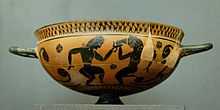Komast Cup
The Komast cup (also Comast cup) is a cup shape at the beginning of the development of Attic drinking cups.

Drinking cups were introduced to Greece from Levantine predecessors. Komast cups were a development of such Levantine cups, which were widespread especially in Ionia and Corinth. Like other vase painters of the time, the Attic painters were under strong influence from Corinthian vase painting. The typical hemispherical shape with a distinguished lip and a low foot of only 1-2 cm height was an Attic development. The interior of the cups is black, only a narrow stripe or band below the lip is left in the base clay colour. The foot and the exterior of the handles are also black. The first specimens were quite large, but throughout the period of their production, the cups became gradually smaller. The most important painters of Komast Cups formed the so-called Comast Group, with the KX Painter as its most significant member. The name is derived from the artists’ preferred theme, the komos, a motif closely connected with Etruscan vase painting.
Bibliography
- Thomas Mannack: Griechische Vasenmalerei. Eine Einführung, Theiss, Stuttgart 2002, p. 108f. ISBN 3-8062-1743-2
Source of translation
| Wikimedia Commons has media related to Komast cups . |